Piper J-3 / L-4
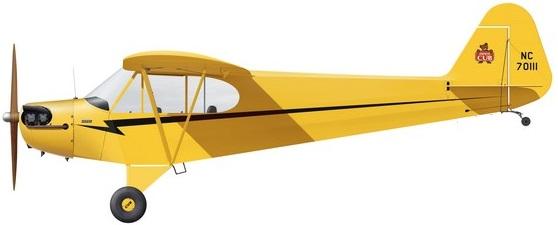
Piper J-3C-65 Cub
© Gaetan Marie - Bravo bravo aviation
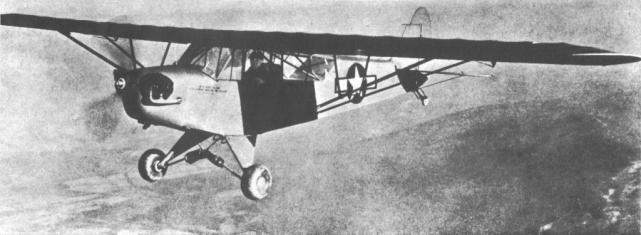
Piper L-4
Photo : auteur inconnu - author unknown
Développement - Development
En 1926 (1927 selon un autre source), Clarence Gilbert Taylor et son frère Gordon A. Taylor fondent à Rochester, New York, la Taylor Brothers Aircraft Manufacturing Company, renommée Taylor Brothers Aircraft Corporation après le décès lors d'un crash de Gordon Taylor en avril 1928. La société commercialisait le Taylor Chummy, un monoplan biplace à aile haute.
In 1926 (1927 according to another source), Clarence Gilbert Taylor and his brother Gordon A. Taylor founded in Rochester, New York, the Taylor Brothers Aircraft Manufacturing Company, redesignated Taylor Brothers Aircraft Corporation after the death of Gordon Taylor during a crash landing in April 1928. The company marketed the Taylor Chummy, a two-seat high wing monoplane.
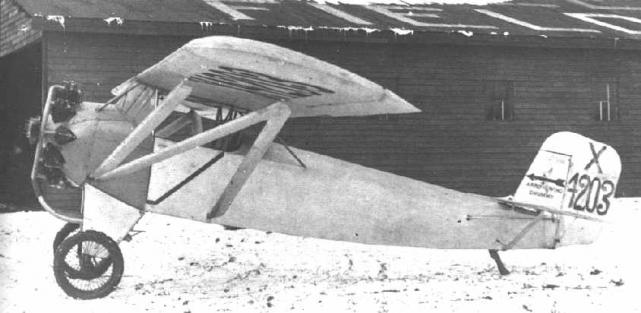
Taylor Chummy
Photo ; auteur inconnu - author unknwon
La société se déplaça en septembre 1929 à Bradford, Pennsylvanie pour s'agrandir et s'appuyer sur des investisseurs dont William Thomas Piper. En 1930 (ou 1931), la société fit faillite et fut rachetée par W.T. Piper. La même année fut créé le Taylor E-2 Cub, une évolution du Chummy mais aussi un avant-goût du Piper Cub.
The company moved in September 1929 in Bradford, Pennsylvania to extend with the help of on investors of which William Thomas Piper. In 1930 (or 1931), the company went bankrupt and was purchased by W.T. Piper. The same year was created the Taylor E-2 Cub, an evolution of Chummy but also a first step to the Piper Cub.
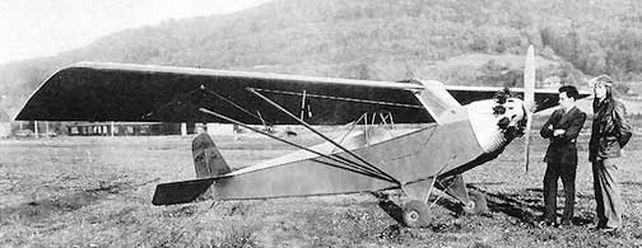
Taylor E-2
Photo ; auteur inconnu - author unknwon
Walter Corey Jamouneau, jeune ingénieur de la compagnie, fit évoluer le Taylor Cub en Taylor (plus tard Piper) J-2 Cub en 1935 (ou 1936), le J signifiant Jamouneau.
Walter Corey Jamouneau, junior engineer of the company, revamped the Taylor Cub in Taylor (later Piper) J-2 Cub in 1935 (or 1936), the J meaning Jamouneau.
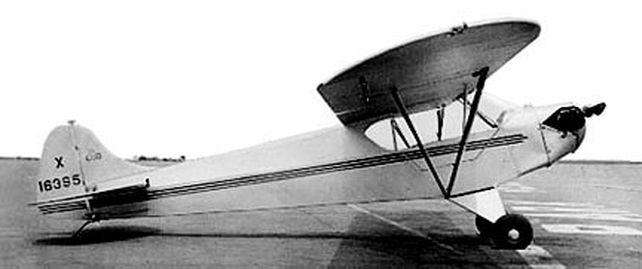
Taylor J-2
Photo ; auteur inconnu - author unknwon
En 1937 fut fondée la Piper Aircraft Corporation qui fut déplacée, suite à un incendie, à Lock Haven, Pennsylvanie (le site actuel de Piper). Jamouneau fit évoluer le J-2 en J-3 en 1938.
In 1937 the Piper Aircraft Corporation was founded and moved, after a fire, to Lock Haven, Pennsylvania (the present Piper plant). Jamouneau redesigned the J-2 in J-3 in 1938.
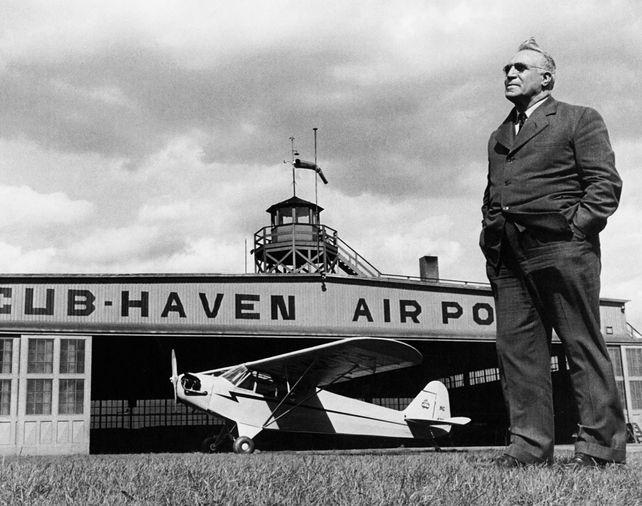
Piper J-2 & William T. Piper
© Piper Aviation Museum - Museum Page Updates and Info
Les premiers modèles de J-3 furent équipés de moteurs Continental, Lycoming ou Franklin de 40 cv (30 kW) puis de 50 cv (37 kW). De 1938 à 1940, la puissance moteur passa à 55, 60 et 65 cv (48 kW).
The first J-3 units were fitted with Continental, Lycoming or Franklin 40 h.p. (30 kW) engines, then further with 50 h.p. (37 kW) engines. From 1938 to 1940, the engine power raised to 55, 60 and 65 h.p. (48 kW).
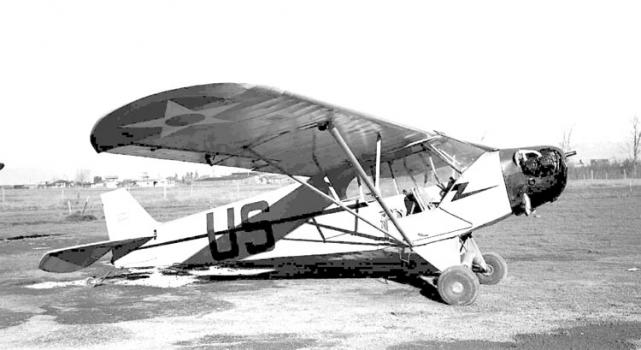
Piper J-3 Cub, 1942
Creative Commons (CC) conditions © Bill Larkins www.flickr.com
La déclaration de guerre en 1939 et la perspective probable de l'entrée en guerre des USA accentua le besoin de pilotes. Le J-3 Cub devint rapidement un avion d'entraînement dans le cadre du CPTP (Civilian Pilot Training Program) et la production s'accéléra : 1806 avions en 1939, 3017 en 1940 et 3197 en 1941.
The 1939 declaration of war and the probable coming involvment in war of the USA accentuated the need for pilots. The J-3 Cub quickly became a primary trainer aircraft of the CPTP (Civilian Pilot Training Program) and the production increased : 1,806 airplanes in 1939, 3,017 in 1940 and 3,197 in 1941.
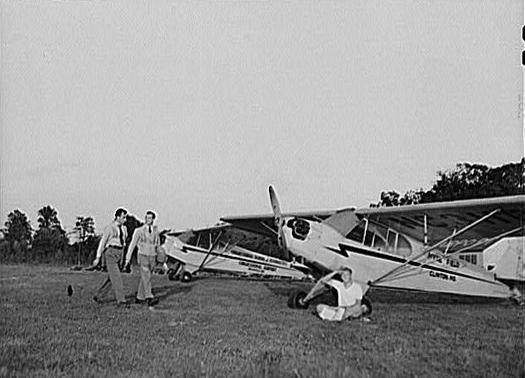
Piper J-3 Cub, 1941, Civilian Pilot Training Program
Author John Vachon - US Federal Government (domaine public - Public domain)
Peu avant la guerre, le J-3 fit l'objet d'un programme de levée de fond pour soutenir l'Angleterre : W.T. Piper et Franklin Motors firent don d'un Piper J-3 pour un tirage au sort et encouragèrent les distributeurs à travers le pays à en faire autant. 48 J-3 furent dédiés le 29 avril 1941 à une opération de levée de fonds à New York, à laquelle participèrent des officiers de la Royal Navy du HMS Malaya.
Just before the war, the J-3 was part of a fund raising program to support England : W.T. Piper and Franklin Motors
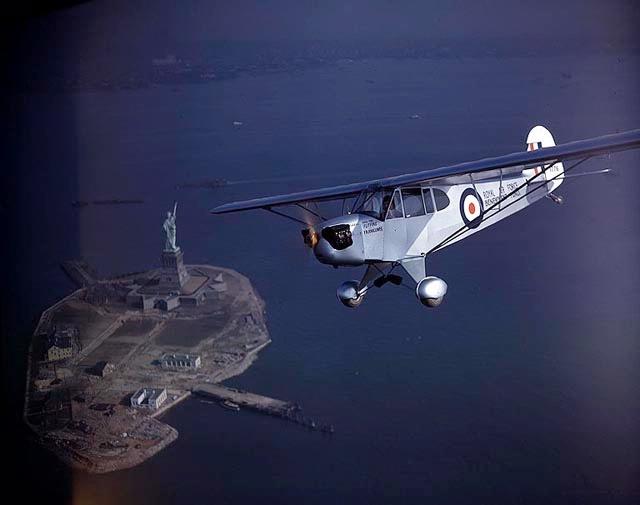
Piper J-3F Cub Flitfire
© National Air and Space Museum Archives, Smithsonian Institution - Image Number: SI-2002-11666 website
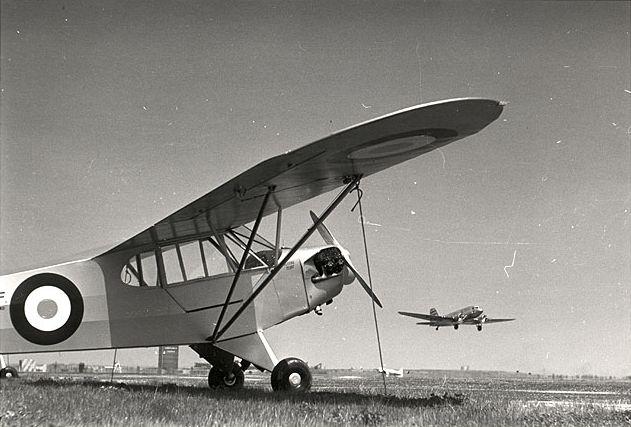
Piper J-3F Cub Flitfire
© Smithsonian Institution - website
Deuxième guerre mondiale - WWII
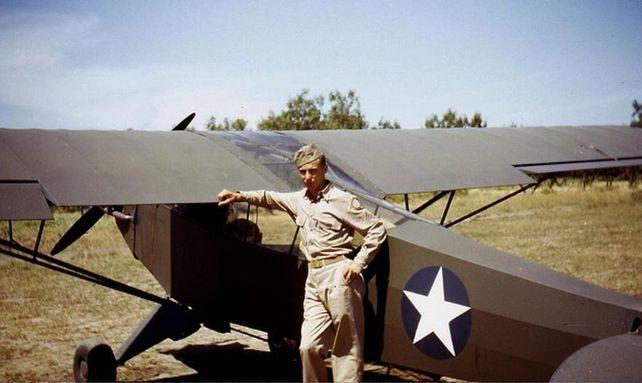
Piper L-4
Photo : auteur inconnu - Author unknown

Piper L-4
Auteur inconnu - Author unknown
A l'approche de la guerre, le Piper J-3 fut rapidement utilisé à des fins militaires : des J-3 civils effectuèrent des missions de reconnaissance sur les côtes américaines pour repérer les U-boot allemands ou les survivants d'attaques de sous-marins.
With the war to come, the Piper J-3 was quickly used for military operations : civilian J-3s conducted reconnaissance missions on the American coasts to locate German U-boots or survivors from submarines attacks.
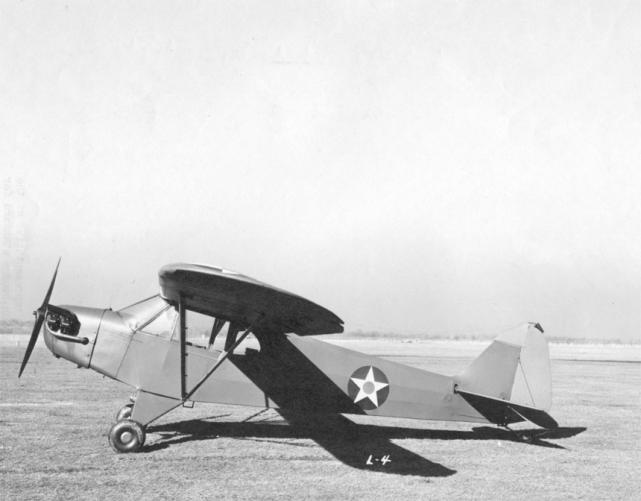 Piper L-4 © US Army (domaine public - public domain)
Piper L-4 © US Army (domaine public - public domain)
En juin 1941, l'Air Corps utilisa des Pipers comme avions d'observation pour les manoeuvres de la Seconde Armée à Camp Forrest dans le Tennesse, puis pour les manoeuvres de la Troisième Armée à Fort Bliss, El Paso, texas. C'est à cette période que le Piper fut surnommé "Grasshopper" ("Sauterelle").
In June 1941, the Air Corps used Pipers as observation aircrafts for the maneuvers of the Second Army at Forrest Camp, Tennesse, then for the maneuvers of the Third Army at Fort Bliss, El Paso, Texas. At this period, the Piper was nicknamed "Grasshopper".
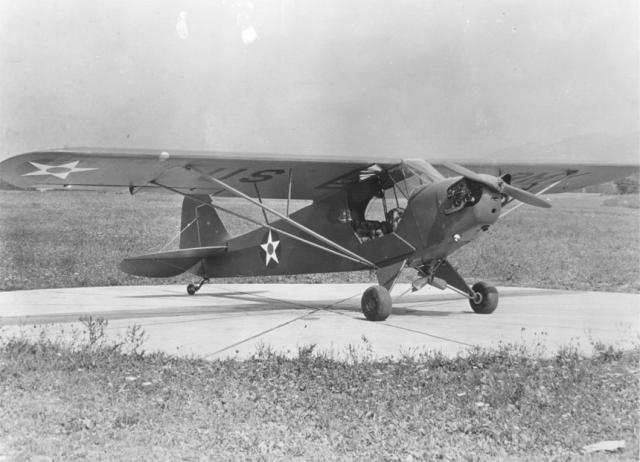
Piper L-4 © US Army (domaine public - public domain)
Piper développa donc une version pour l'armée dont les appellations successives furent O-59 (1941), L-4 (à partir d'avril 1942) ou NE pour l'U.S. Navy. Le L-4 "Grasshopper" était similaire au J-3 Cub civil avec simplement un panneau de toit en plexiglas et des fenêtres arrière pour une meilleure visibilité.
Piper developed a military variant successively designated O-59 (1941), L-4 (from April 1942) or NE for the U.S. Navy. The L-4 Grasshopper was similar to the J-3 civilian Cub with a Plexiglas skylight and rear windows for improved visibility,
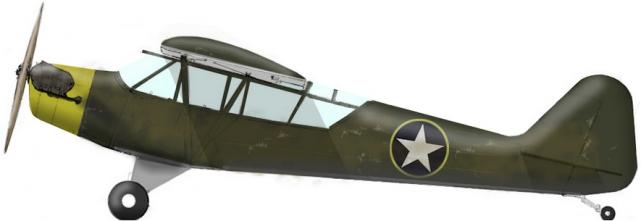
Piper L-4 Cub, 1943 - Auteur inconnu - Author unknown
Peu après Pearl Harbor, Piper Aircraft Corporation reçut une commande de 40 Cubs, puis de 750. 5413 L-4 furent produits pour les forces armées américaines dont 230 NE-1 et 20 NE-2 pour la Marine US.
Shortly after Pearl Harbor, the Piper Aircraft Corporation received an order for 40 Cubs and then for 750 units. 5,413 L-4s were produced for american military forces, including 230 NE-1 and 20 NE-2 for the U.S. Navy.
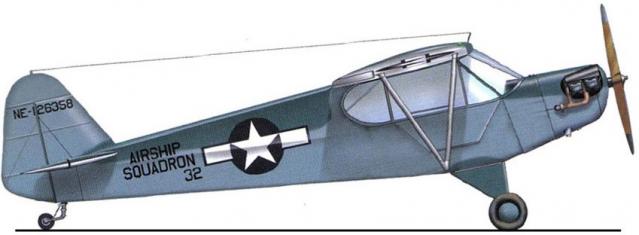
Piper NE-1, Airship Squadron 32 (ZP-32), N.A.S. Moffet Field, California, 1942
Auteur inconnu - Author unknown
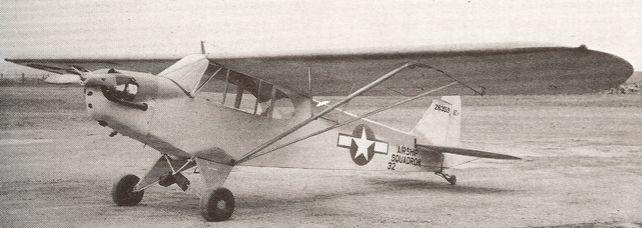
Piper NE-1 (BuNo 26359), Airship Squadron 32, N.A.S. Moffet Field - © Austin J. Brown (
┼)
Le Piper Cub fut utilisé sur presque tous les théâtres d'opérations pour des missions de réglages de tir d'artillerie, de liaison, de transport, de reconnaissance, de photographie aérienne ou d'ambulance. Lors de certains débarquements, des Cubs furent lancés depuis des ponts spéciaux sur des LST.
The Piper Cub was used in almost every operations theater for various missions such as artillery fire direction, liaison, transports, reconnaissance, aerial photography or ambulances. In some landing operations, Cubs were launched from special decks constructed on LST's.
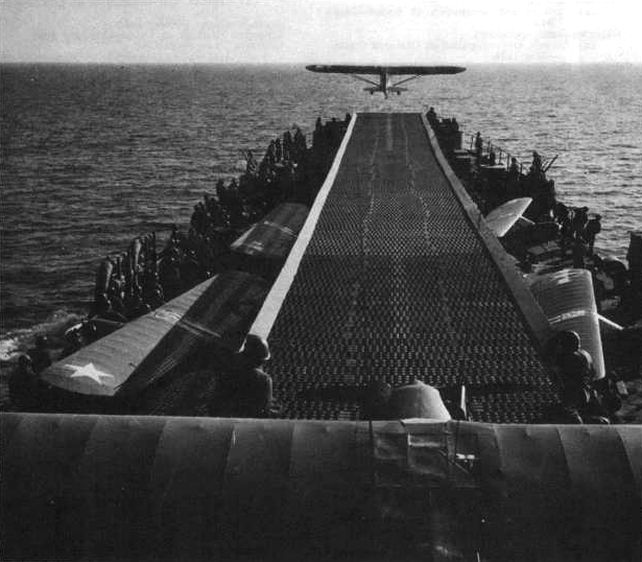

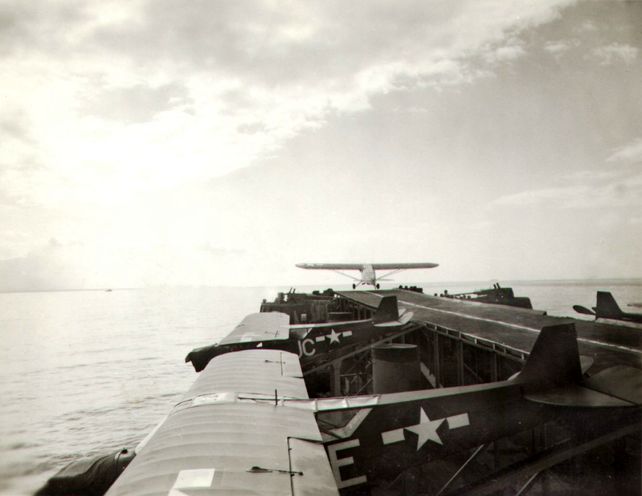
Piper L-4 - Décollage depuis un LST - Take off from a LST.
© US Army (domaine public - public domain)
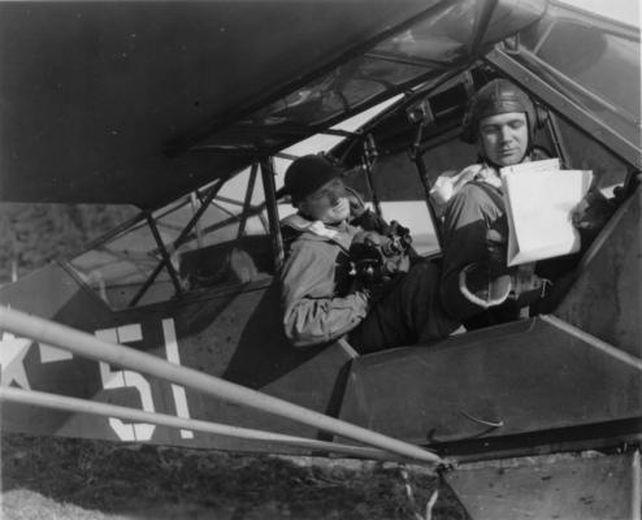
Piper L-4 - Région du Rhin - Rhine area
© US Army (domaine public - public domain)
BELGIQUE - BELGIUM
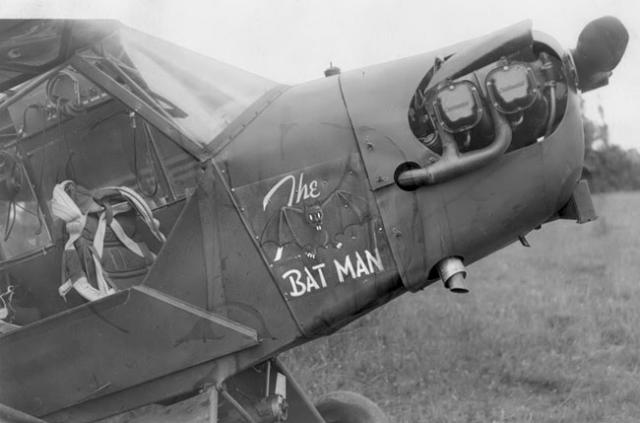
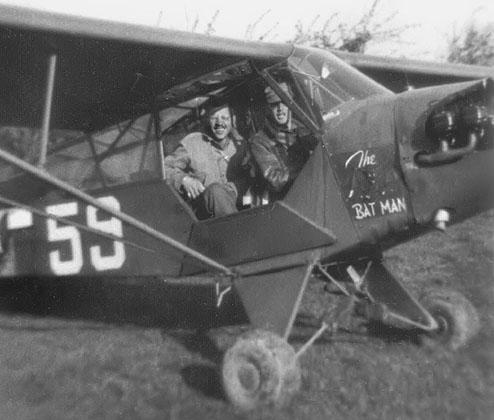
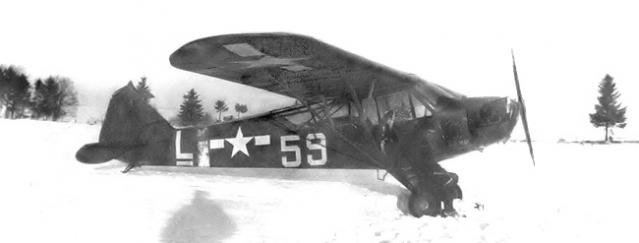
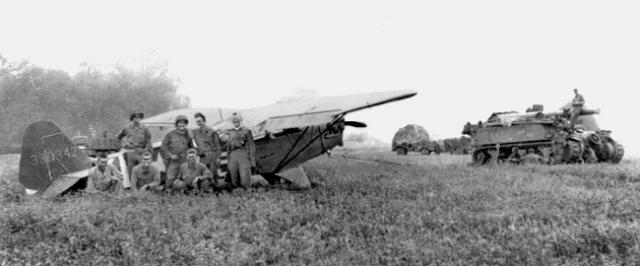
Piper L-4 "The Batman", 991st FA Bn
Utilisé par Jim Lowe (pilote) et Adrian E. Kibler (observateur) jusqu'au 15 janvier 1945.
Flown by Jim Lowe (pilot) and Adrian E. Kibler (observer) up to January 15, 1945.
© Adrian Kibler family - Adrian E. Kibler photo collection
ANGLETERRE - ENGLAND
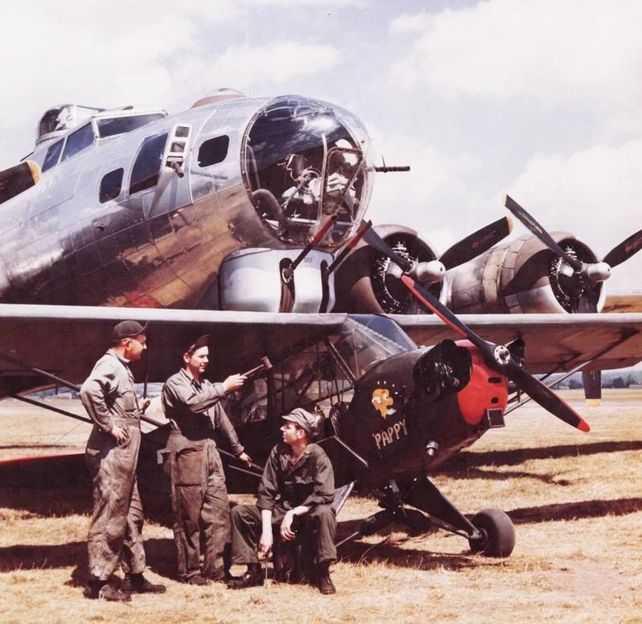
Piper L-4 - Photo : auteur inconnu - author unknown
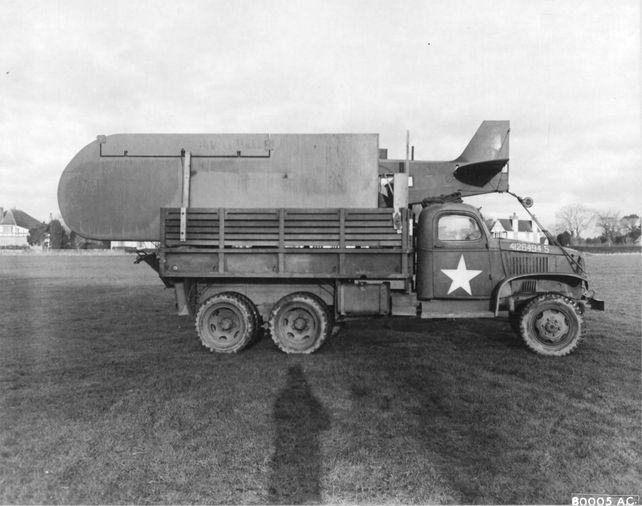
Piper L-4 - Devon, Angleterre, 12 février 1944 - Devon, England, February 12th, 1944.
© US Army (domaine public - public domain)
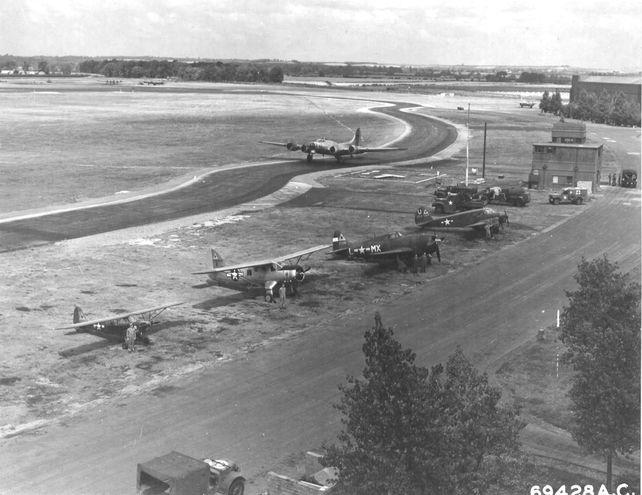
Piper L-4 - RAF Bassingbourn, Cambridgeshire, England, 1945.
© US National Archives (domaine public - public domain)
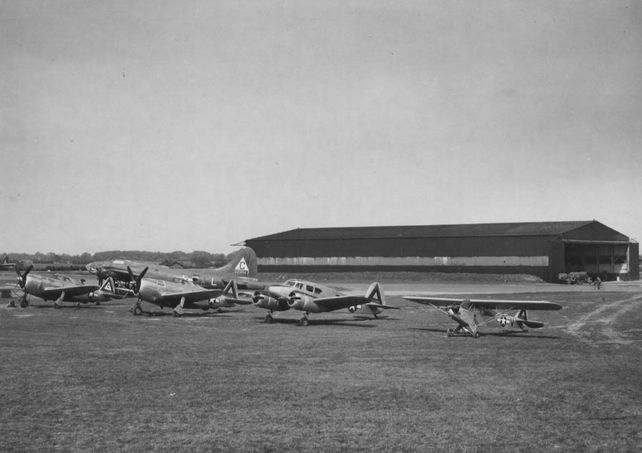
Piper L-4 - 303rd Bomb Group, England. 23rd April, 1945.
Photo : auteur inconnu - author unknown
FRANCE - FRANCE
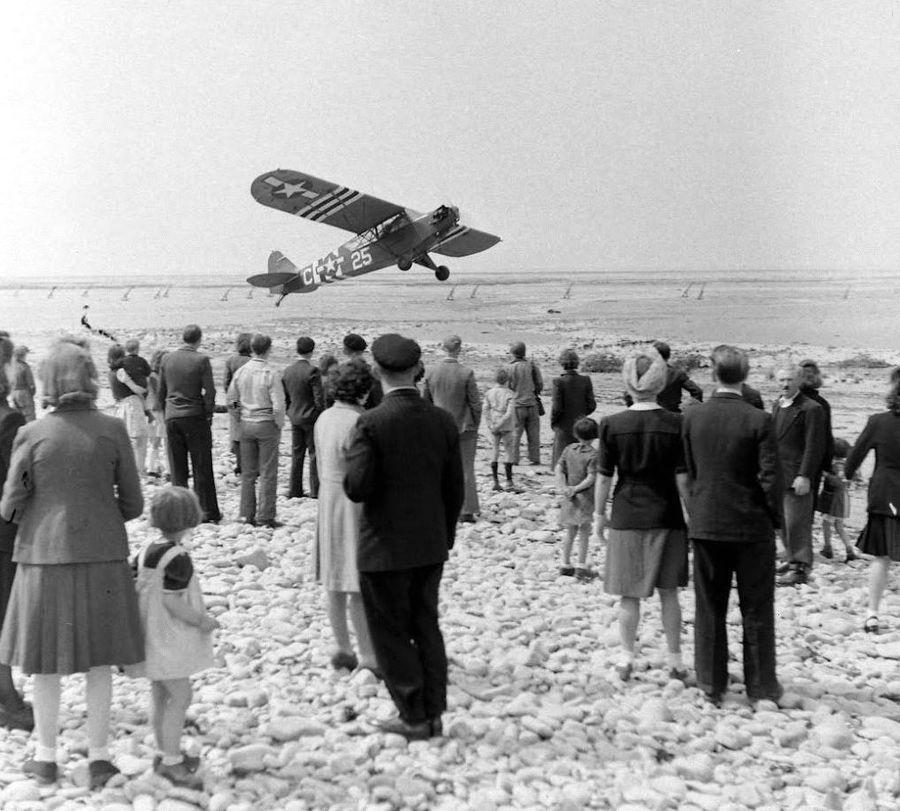
Piper L-4 - Grandcamp, Normandie/Normandy, France, 1944
© US Army (domaine public - public domain)
D'autres Cubs furents envoyés sur des zones de combats en avions cargos ou en camions puis assemblés sur place. En juin 1944 en Normandie, des L-4 furent utilisés pour leur vitesse très lente pour repérer les chars allemands.
Other Cubs were shipped into the combat zones in cargo planes or trucks and assembled on site. In June 1944, in Normandy, L-4s were used for their slow speed to spot German tanks.
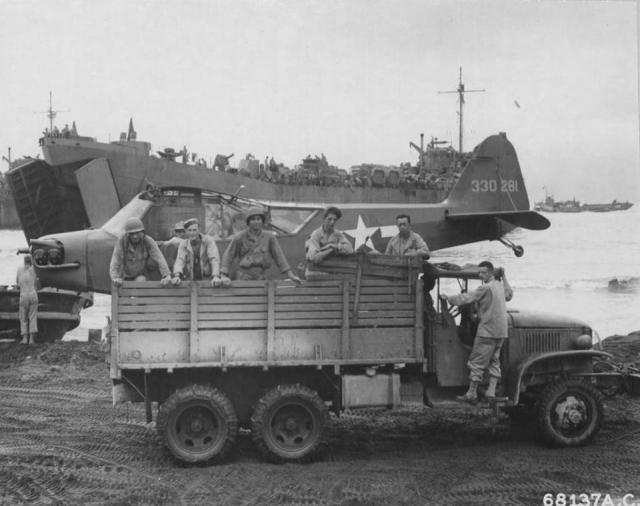
Piper L-4 - © Benoît Blattlin - GPPA
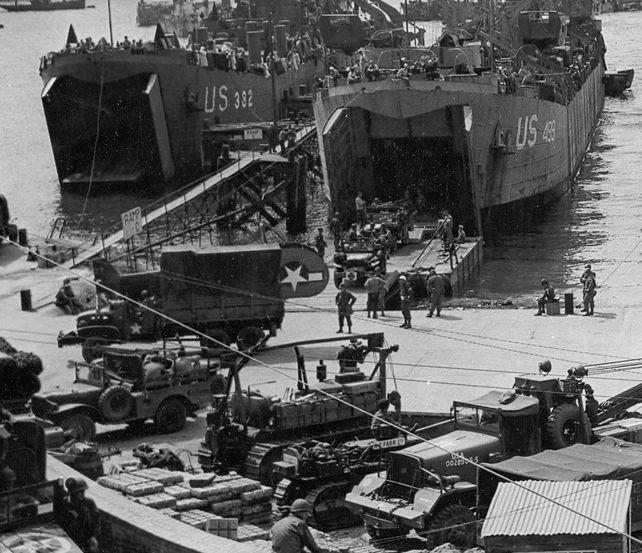
Piper L-4 - © Ham and Jam - http://ham-jam.org
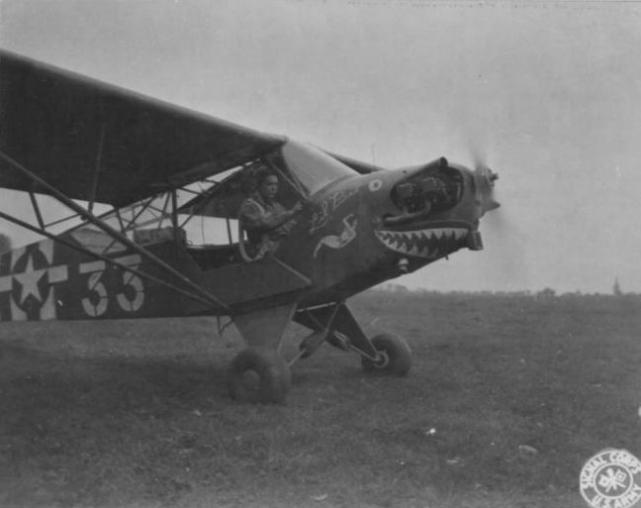
Piper L-4 - France - Novembre 1944 - November 1944.
© US Army (domaine public - public domain)
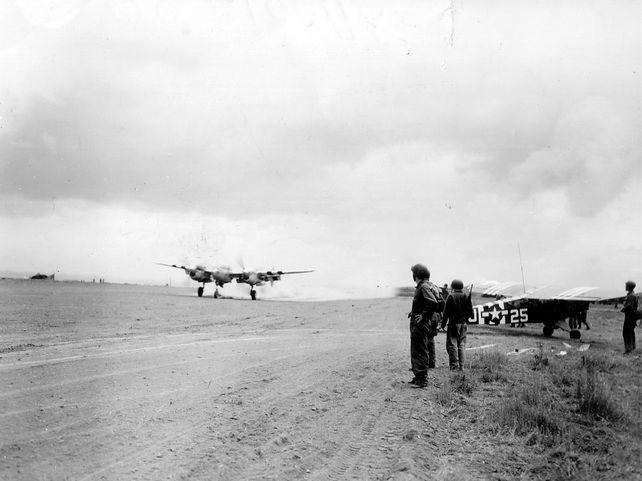
Piper L-4 & Lockheed P-38 Lightning - © Ham and Jam - http://ham-jam.org
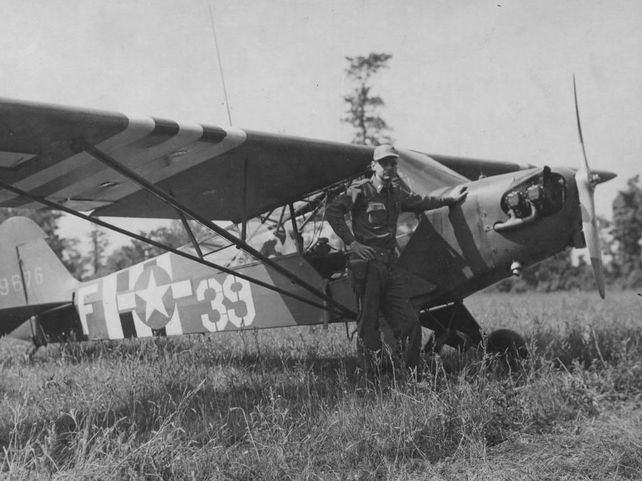
Piper L-4 - 1st Lt. John J. Donnelan (New York).
Photo : auteur inconnu - author unknown
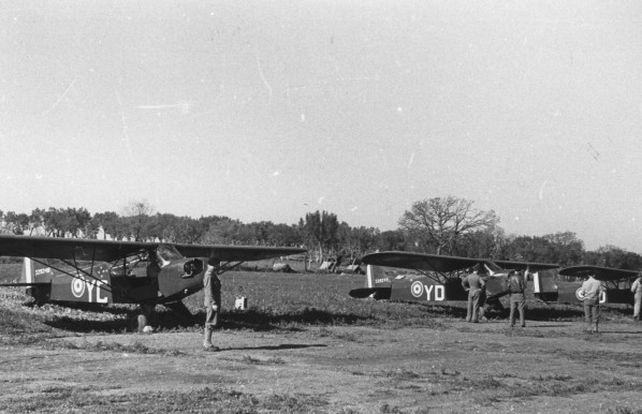
Piper L-4 "Puce" "YC" (Général Juin) & YD.
© ECPAD - www.ecpad.fr
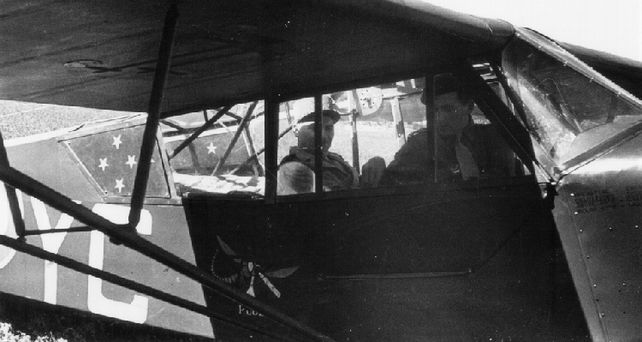
Piper L-4 "Puce"- Général Juin & Corentin Le Pape (pilote).
© ECPAD - www.ecpad.fr
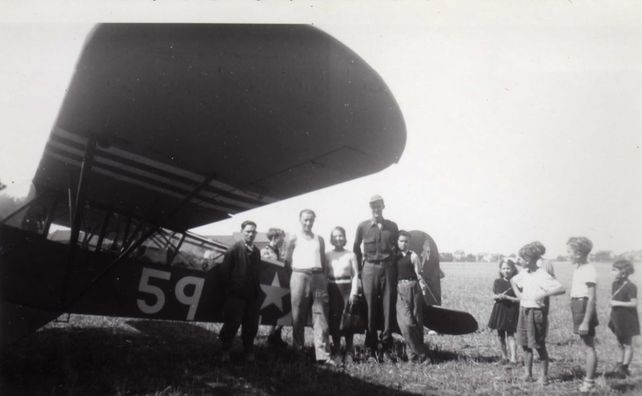
Piper L-4 © Kubel Lili Ma Kubelwagen Lili
ITALIE - ITALY
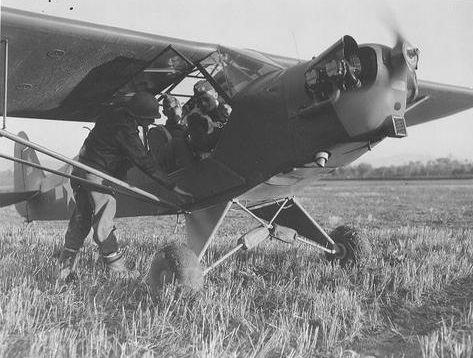
Piper L-4 "Grasshopper", 1943
Général Mark Wayne Clark et son pilote Major John Thornton Walker (place avant).
General Mark Wayne Clark and his pilot Major John Thornton Walker (front seat).
© US Army (domaine public - public domain)
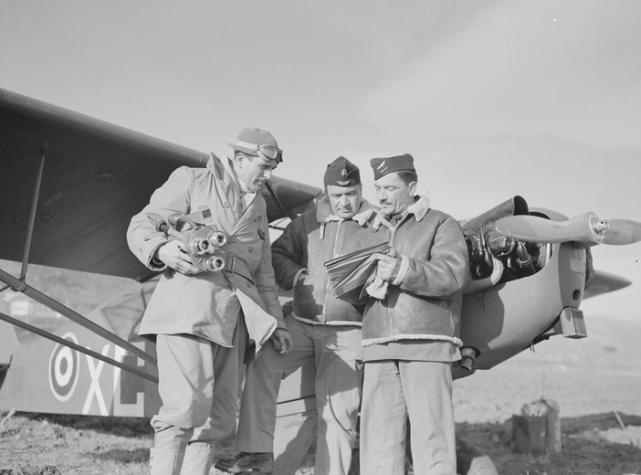
Piper Cub 67e régiment d'artillerie d'Afrique, 3e division d'infanterie algérienne
Raymond Méjat (à gauche - left) - Capitaine Morin (centre - center)
Belvédere, Italie, février 1944 - Belvedere area, Italy, February 1944
© ECPAD - ref TERRE-169-3619 - www.ecpad.fr
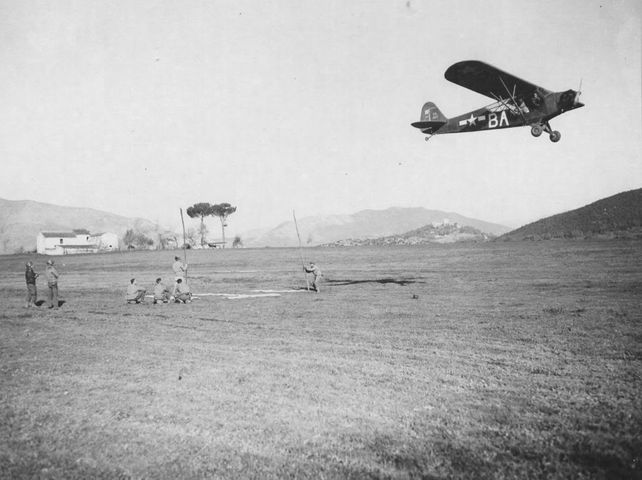
Piper L-4 - ramassage du courrier - message pick up.
Photo : auteur inconnu - author unknown
BIRMANIE - BURMA
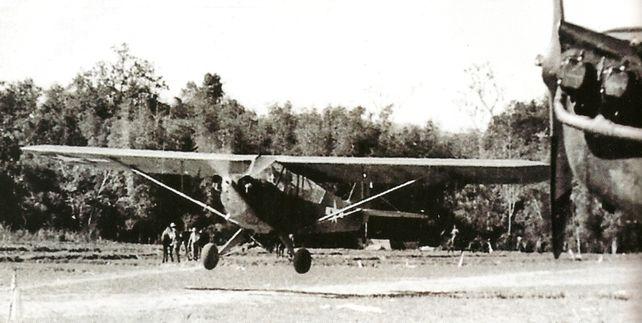
Piper L-4 "Grasshopper"
Un L-4 emporte un blessé et décolle d'une piste sommaire près de Hsamshingyaung le 15 avril 1944.
A L-4 takes off with an injured person from a summary track near Hsamshingyaung on 15th April, 1944.
© US National Archive (domaine public - public domain)
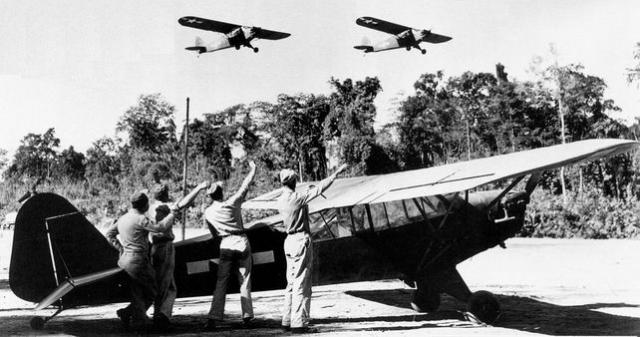
Piper L-4 B
Quelque part en Birmanie - Somewhere in Burma.
© USAAF (domaine public - public domain)
INDES ORIENTALES NEERLANDAISES - NETHERLANDS EAST INDIES
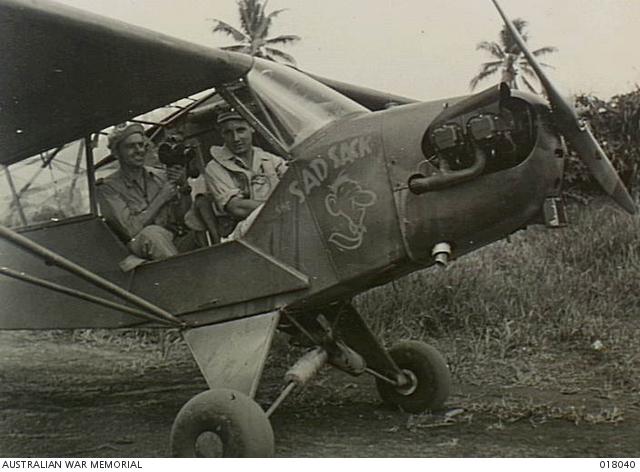
Piper Cub "The Sad sack".
25 janvier 1945. Piper utilisé pour la direction de tirs d'artillerie sur les positions japonaises des Halmaheras. Equipage : Lt W.N. Brisley (pilote) et William Carty (Département de l'information).
25th January, 1945. Piper used for directing artillery fire against Japanese positions in the Halmaheras. Crew : Lt W.N. Brisley (pilot) and William Carty (Department of Information).
Picture with courtesy of Australian War Memorial (http://www.awm.gov.au) - Domaine public - Public domain.
LES PHILIPPINES - THE PHILIPPINES
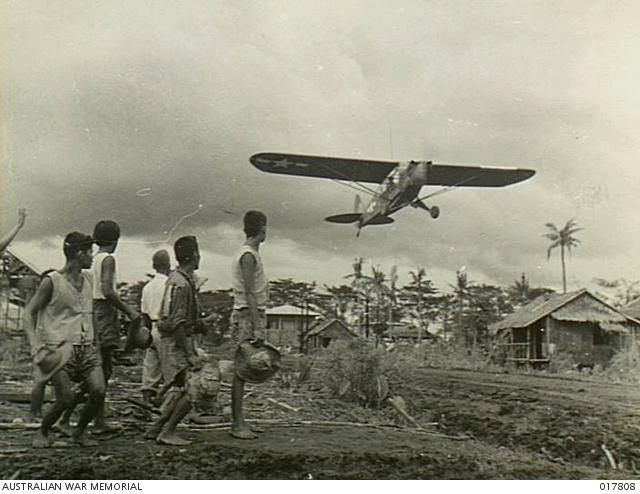
Piper Cub
Octobre 1944, décollage d'une route d'Alanang-Alang.
October 1944, taking off on a roadway in Alanang-Alang.
Picture with courtesy of Australian War Memorial (http://www.awm.gov.au) - Domaine public - Public domain.
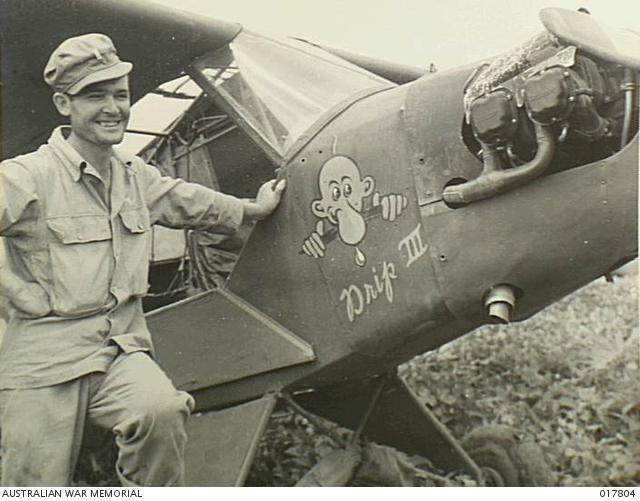
Piper Cub "Drip III" - Lt James Power (Nebraska)
Picture with courtesy of Australian War Memorial (http://www.awm.gov.au) - Domaine public - Public domain.
NOUVELLE GUINÉE - NEW GUINEA
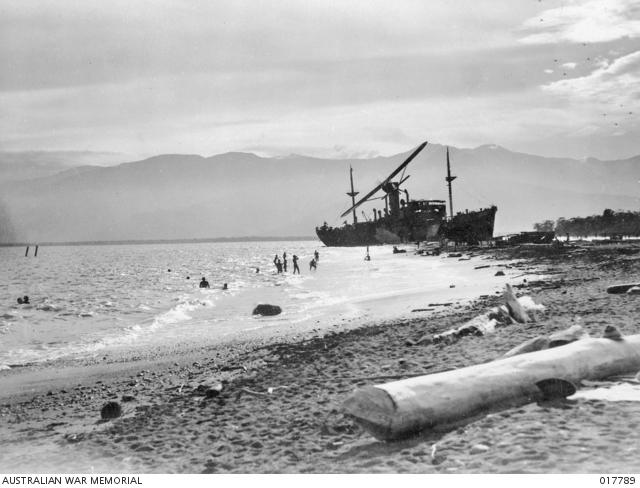
Piper Cub - Malahang
Un Piper survole l'épave du bateau japonais Myokomaru en septembre 1943.
A Piper on patrol over the the wreck of the Japanese ship Myokomaru in September, 1943.
Picture with courtesy of Australian War Memorial (http://www.awm.gov.au) - Domaine public - Public domain.
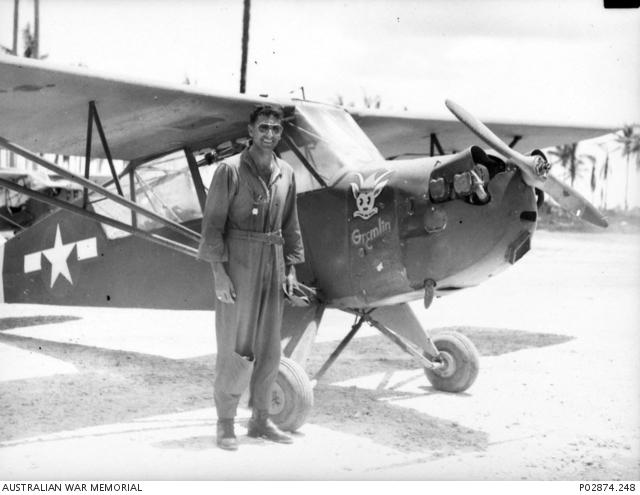
Piper Cub "Gremlin", Los Negros, Admiralty Islands
Aérodrome Momote, septembre 1944 - Momote airfield, September, 1944.
Picture with courtesy of Australian War Memorial (http://www.awm.gov.au) - Domaine public - Public domain.
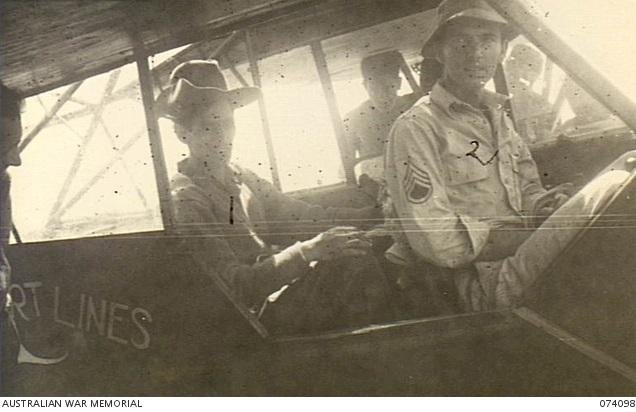
Piper Cub, Dugumur Bay
Suphdev Singh, 1/14th Punjab Regiment, Royal Indian Army Service Corps, évacué vers Madang pour des soins médicaux le 14 juin 1944.
Suphdev Singh, 1/14th Punjab Regiment, Royal Indian Army Service Corps, flown out to Madang for medical treatment on 14th June, 1944.
Picture with courtesy of Australian War Memorial (http://www.awm.gov.au) - Domaine public - Public domain.
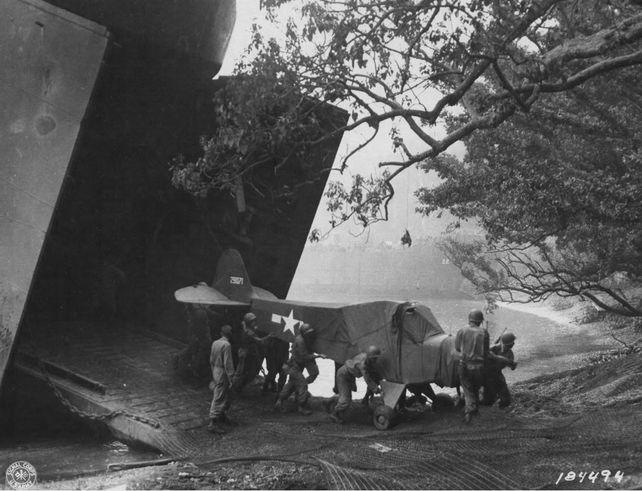
Piper L-4
Déchargement d'un LST, 2 janvier 1944, Nouvelle-Guinée - Unloaded from an LST, 2 January, 1944, New-Guinea.
© USAAF (domaine public - public domain)
NOUVELLE BRETAGNE - NEW BRITAIN
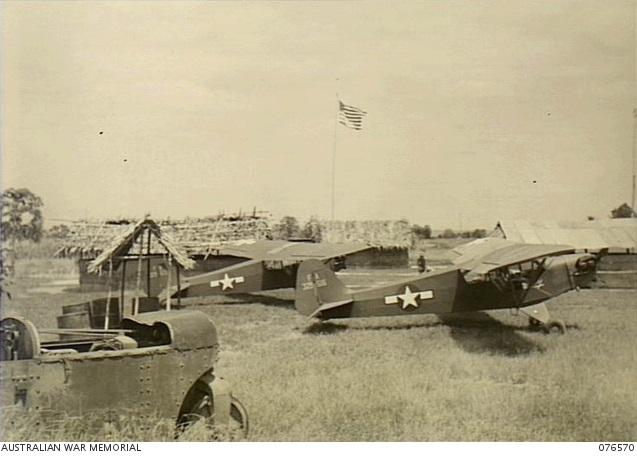
9 octobre 1944 - 9th October, 1944.
Picture with courtesy of Australian War Memorial (http://www.awm.gov.au) - Domaine public - Public domain.
19 828 Piper ont été fabriqués : 14 125 en version civile et 5 703 en version militaire. D'autres sources évoquent 19 888 au total, ou 5 413 en version militaire. 150 Piper supplémentaires auraient été fabriqués au Canada ainsi que 253 planeurs TG-8.
19,828 Pipers were built : 14,125 civil variants and 5,703 military variants. Other sources mention a total of 19,888 or 5,413 military variants. 150 extra Pipers would have been built in Canada and 253 TG-8 glider variants.
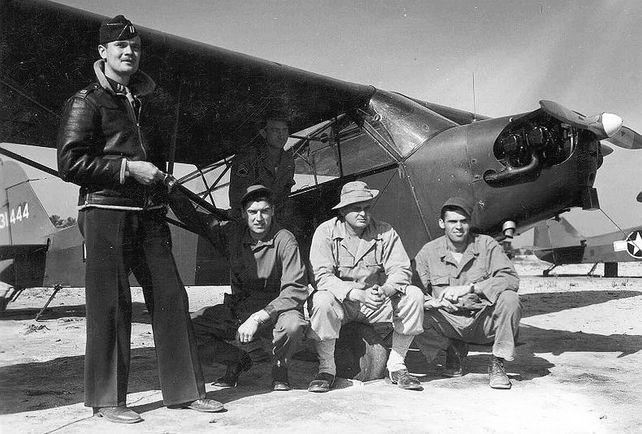
Piper L-4 - © Ham and Jam - http://ham-jam.org
Quelques anecdotes - Single stories
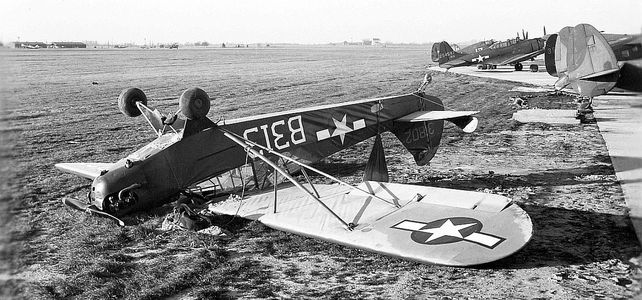
Piper L-4 - Photo :Auteur inconnu - Author unknown
"Rosie the Rockeeter"
Lt. Col. Charles Carpenter, surnommé "Bazooka Charlie", ou The Mad Major (le Major fou) était officier de l'U.S. Army officer connu pour avoir détruit des tanks et véhicules blindés ennemis avec un L-4 Grasshopper nommé "Rosie the Rockeeter" et équipé de bazookas. Une de ses missions les plus réputées fut celle du 20 septembre 1944, lors de la bataille d'Arracourt près de Nancy.
Lt. Col. Charles Carpenter, nicknamed "Bazooka Charlie" or The Mad Major was a U.S. Army officer famous for having destroyed enemy tanks and armored vehicles with a L-4 Grasshopper nicknamed "Rosie the Rockeeter" fitted with bazookas. One of his most famous mission happended on 20th September, 1944, during the Battle of Arracourt near Nancy (Eastern France).
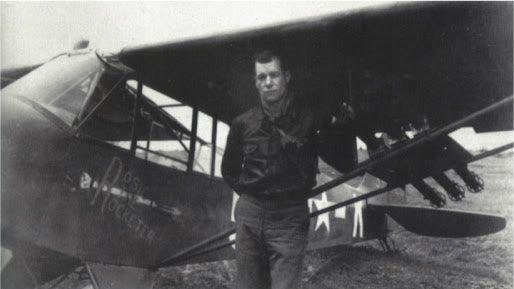
Piper L-4 "Rosie the Rockeeter" & Lt. Col. Charles Carpenter
© Mrs. E Carpenter - Fair use according to US copyright law
Les Allemands lancèrent une attaque contre le QG du Commandement de la 4ème Division Blindée ; malgré le brouillard, Carpenter décolla avec son L-4 et quand le brouillard se leva, il repéra des tanks Panther et des véhicules blindés avançant vers Arracourt. Il attaqua malgré les tirs venant du sol et tira toutes ses roquettes puis retourna à deux reprises recharger pour attaquer de nouveau. Il tira en tout seize roquettes, immobilisa deux chars allemands, des véhicules blindés et tua ou blessa une douzaine de soldats ennemis. Le reste des chars se retira.
The germans launched an attack on the HQ of the 4th Armored Division's Combat Command ; despite the fog, Carpenter took off with his L-4 and when the fog began to lift, he spotted German Panther tanks and armoired vehicles advancing towards Arracourt. He attacked them despite the ground fire, fired all his rockets then flew back twice to reload and attack again. He fired a total of sixteen rockets, stopped two German tanks and several armored vehicles and killed or wounded a dozen of enemy soldiers. The remaining tanks retreated.
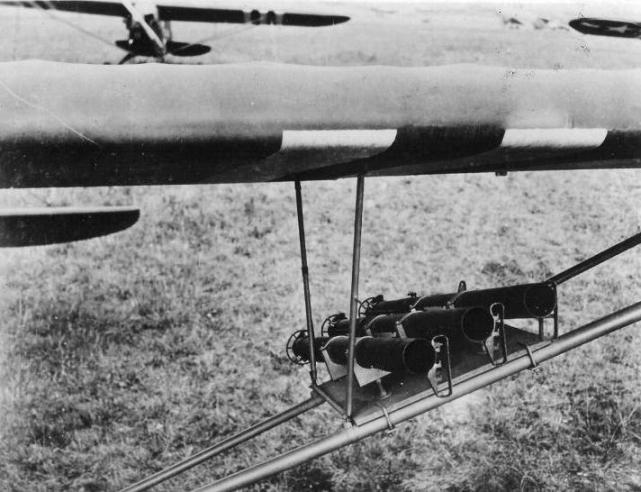
Piper L-4 - avec bazookas, France, 24 octobre 1944 - with bazookas, France 24th October, 1944.
© USAAF (domaine public - public domain)
"Tenez bon, nous arrivons !" " Don't give up, we arrive !"
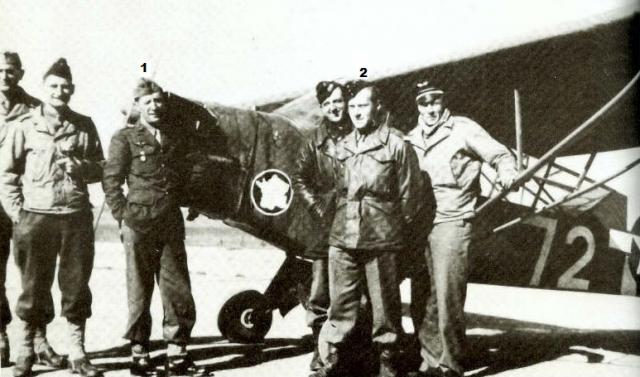
Piper L-4, capitaine Callet (1) & lieutenant Mantoux (2)
© www.unaalat.fr
Le 24 août 1944, le Piper L-4 "A-72" (n° 43-29911) avec comme pilote le capitaine Jean Callet et comme observateur le lieutenant Étienne Mantoux, survola Paris à basse altitude et la Préfecture de Police pour transmettre le message du général Leclerc "tenez bon ,nous arrivons" aux résistants. Leclerc avait en effet reçu l'ordre le 23 août vers 19h15 du Général Bradley de foncer sur Paris.
On the 24th August, 1944, the Piper L-4 "A-72" (s/n 43-29911) with Captain Jean callet as pilot and Lieutenant Etienne Mantoux as observer, flown over Paris and the Prefecture of Police at low altitude to deliver the message of General Leclerc "Don't give up, we arrive" to the Resistants.Leclerc just got the order on August 23rd, at 7.15 pm from General Bradley to rush towards Paris.
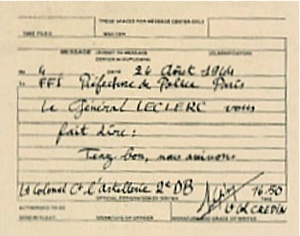
"Tenez bon nous arrivons"
© www.unaalat.fr
Vers 18h05, le Lt Mantoux larguera le message dans un tube lesté près de la préfecture. Au retour, l'appareil sera la cible de nombreux tirs d'armes diverses. Le train droit sera touché et l'appareil se posera dans une prairie près de Monthléry, finissant couché sur l'aile droite. 13 impacts de balles seront relevés.
At about 6.05 pm, the Lt Mantoux dropped the message in a weighted tube near the Prefecture. On the way back, the aircraft was intensively under fire. The right landing gear was hit and the aircraft landed in a field close to Monthlery and finished lying on the right wing. 13 bullet impacts were noticed.
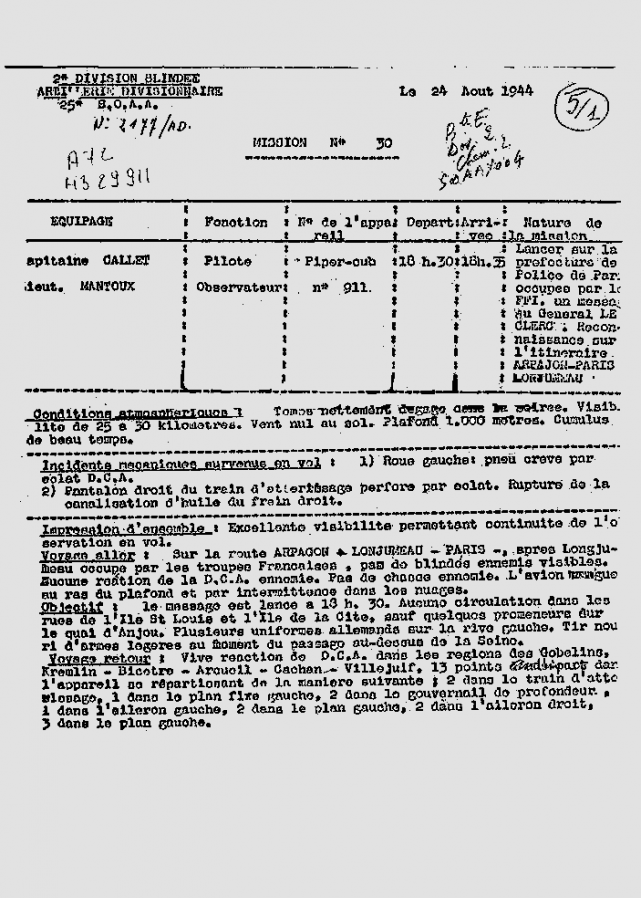
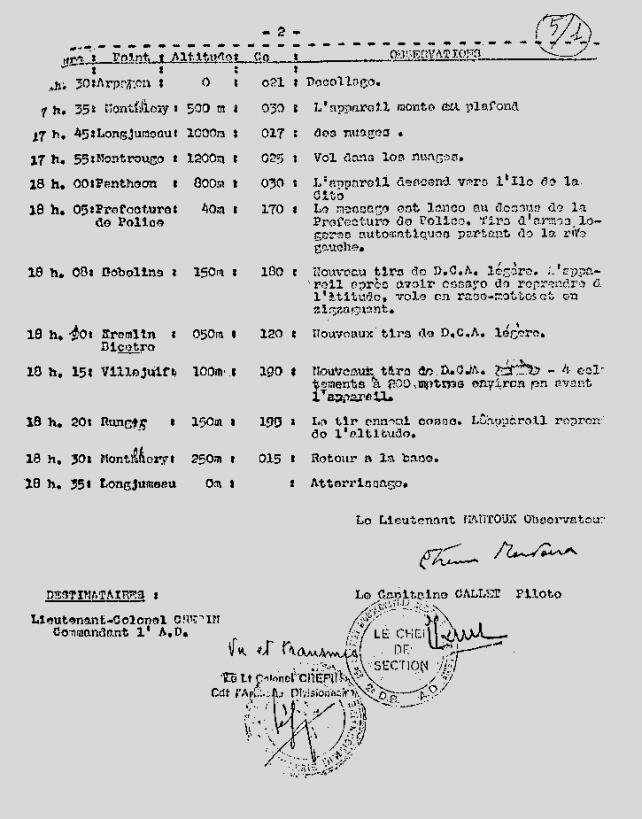
Le rapport de mission - The mission report
© www.unaalat.fr
